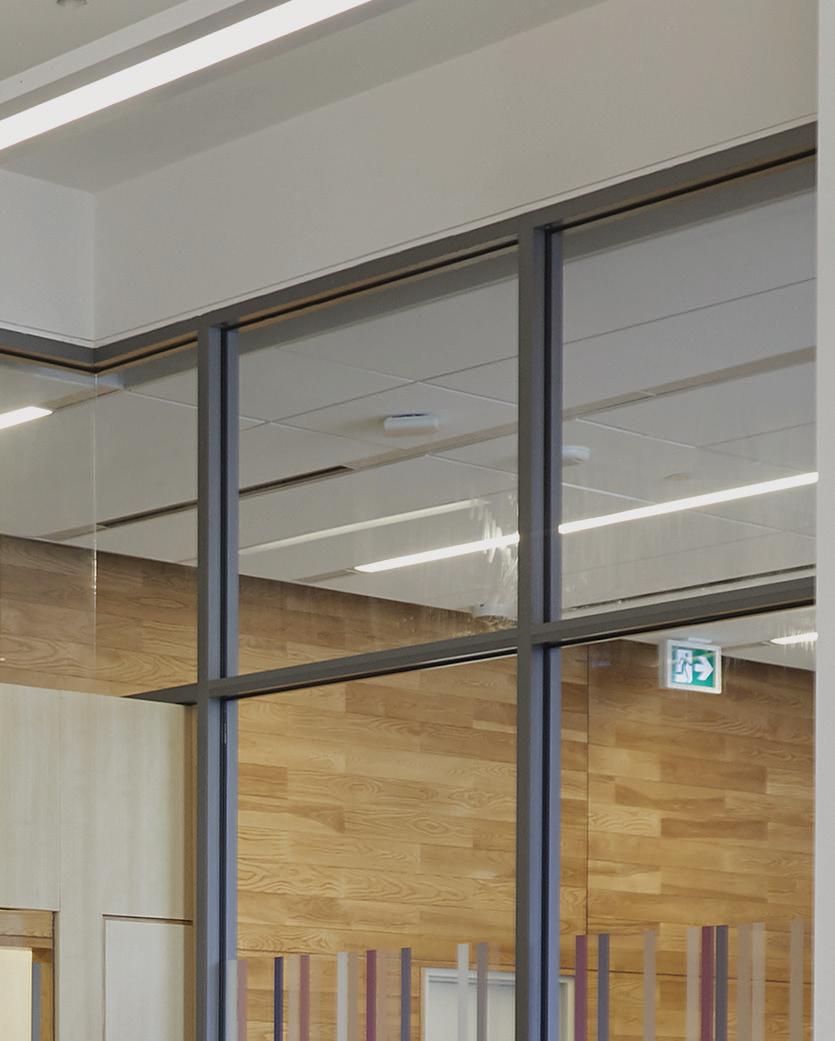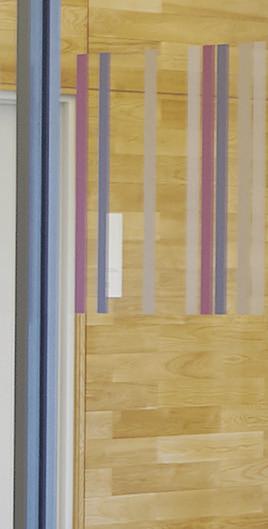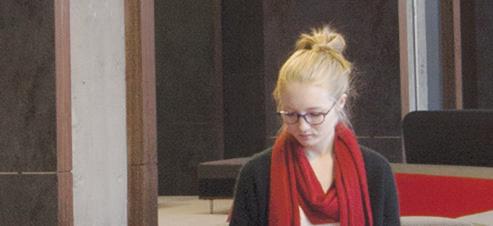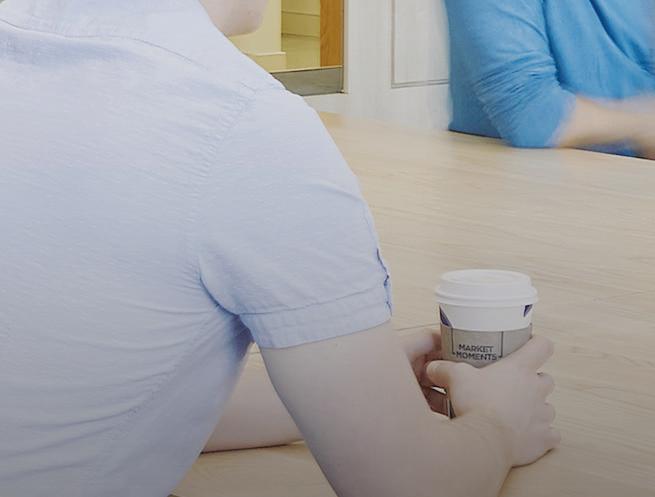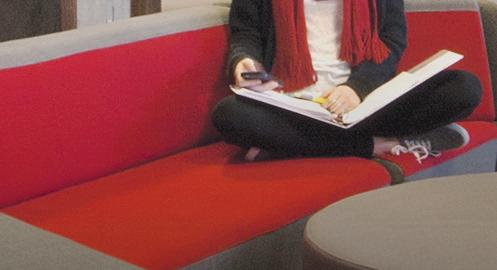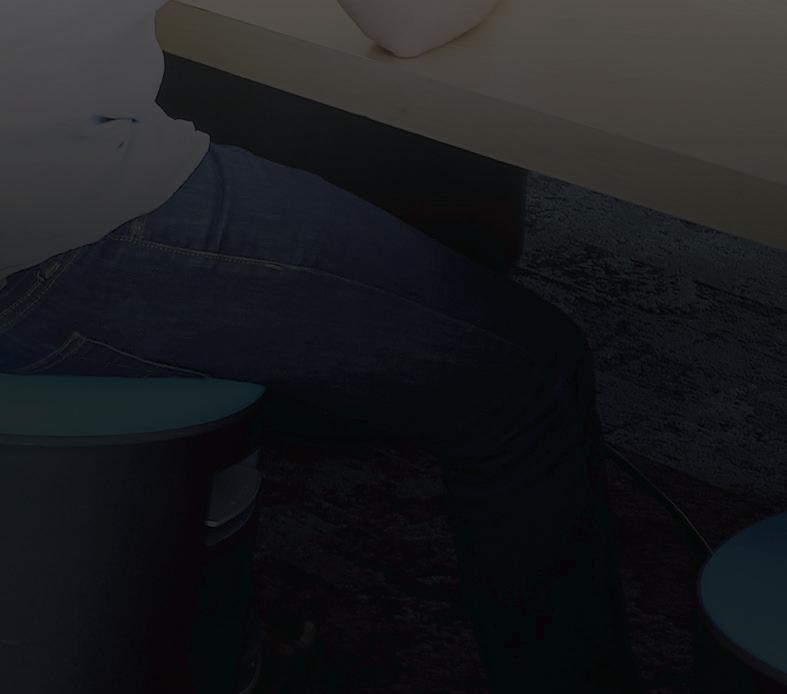
























Open Mon. to Fri.: 8am - 4pm Closed: Sat./Sun.
Last day open before winter break: Monday, Dec. 12 Reopening on Monday, Jan. 9, 2023
Open Mon. to Fri.: 4pm - Late Closed: Sat./Sun.
Last day open before winter break: Friday, Dec. 9 Reopening on Monday, Jan. 9, 2023
The blue doors at Kerr Hall’s Up per Gym spent most of last week closed, with the sounds of squeak ing shoes, basketballs pounding hardwood and encouraging cheers of teammates slipping through. To ronto Metropolitan University (TMU) students weren’t behind the doors though, rather some of the world’s best basketball players.
Canada’s Senior Women’s Na tional Team held a training camp at the university from Nov. 21 to 24 at the Kerr Hall Upper Gym and the Mattamy Athletic Centre. Among the participants was TMU women’s basketball coach Carly Clarke, who is an assistant coach for the national team.
But Clarke wasn’t just on guard for Canada last week, she also had responsibilities with the Bold to tend to. So, when last Wednesday’s national team session ended, she bundled up to brave the cold and was out the door from one practice to another.
“It allows me to be at training camp and still be with our team here at TMU,” said Clarke. “I’m really lucky to get the best of both worlds.”
Clarke has been working in the Canada Basketball system since 2008 and has coached many players who now play professionally all over
the world. One of which is Wom en’s National Basketball Association (WNBA) player Bridget Carleton.
Carleton said she’s known TMU’s bench boss since her time with the 2013 16U national team that Clarke was the head coach of.
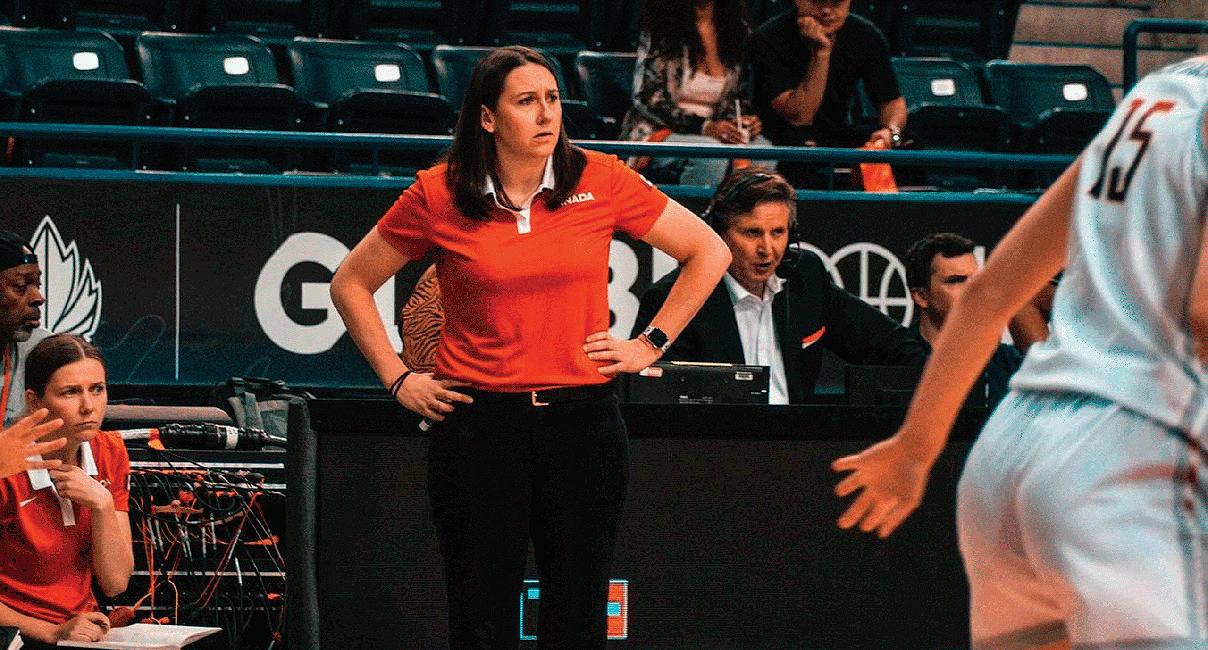
“She obviously has a full time job at TMU but she also dedicates so much time to Canada Basketball and she has for over a decade now to both programs,” said Carleton. “Her dedication and her commitment to Canada Basketball…is incredible and it’s one of one, so we’re really thankful for her.”
Canada is coming off a fourth place finish at the FIBA Women’s Basketball World Cup this year.
The result was the program’s high est finish since 1986 and now they’re ranked fifth in the world.
This fall’s World Cup also marked
the on-court return of Canadian basketball star Kia Nurse, who missed the 2022 WNBA season due to an ACL injury. Nurse con tinued to work her way back to full strength last week at TMU, much to the joy of her teammates.
“Even though she wasn’t here on court with us, she was always around and connected with us,” said Carleton. “But the experience she brings to the table every time she’s on the court and obviously her leadership style and her competi tiveness is invaluable.”
Team Canada doesn’t have any games scheduled in the near fu ture, so last week’s training camp was a chance to keep those repre senting the country connected and provide a chance for them to get better everyday.
The presence of the national team
on campus also excited TMU’s women’s basketball team. Clarke said Seattle Storm head coach Noelle Quinn—who is Canada’s lead-assis tant coach—got to meet the reigning U Sports national champs.
The team’s camp wasn’t just an opportunity to learn for the players but also for Clarke. She explained that her time with Team Canada al lows her to bring things back to the Bold. Clarke referenced a defensive scheme that she worked on with Canada in the morning, that she then brought to the Bold’s practice that afternoon.
“What Carly learns here, we also reap the benefits of that and she gets to bring all her knowledge and what she learns in this space back to us,” said Bold forward Kaillie Hall.
TMU spent this past weekend in Sudbury and North Bay, Ont., as part of a two-game road trip. They’ll play two more games on the road this semester before breaking for the holidays.
The long trips to visiting schools offer some rare downtime for TMU’s resident basketball mastermind.
“We’re well-prepared week-toweek and in what we’re doing for our game plans and prep,” said Clarke. “We’ll get a bus ride tomor row night for a few hours and I’ll get to chill out so it’ll be all good,” said Clarke.
Toronto Metropolitan University (TMU) experts say there are over 50,000 hectares of ready-to-use land overlooked while the provin cial government’s plans to build at least 50,000 new homes on Ontar io Greenbelt land—causing threats to existing infrastructure and the environment.
Bill 23, also know as “The More Homes Built Faster Act” was passed on Nov. 28 in response to the housing crisis in the province. In a statement released Nov. 4, the Ontario govern ment announced plans to remove about 7,400 acres from the edge of the Greenbelt area to accommodate the 1.5 million homes planned to be built in the next 10 years.
The Ontario Greenbelt is an area of protected greenspace around the Golden Horseshoe—from Oak Ridges Moraine in the east to Niagara River in the west. The government plans to build on land located mostly in the Greater Toronto Area (GTA).
But some experts and leaders are sceptical of the project’s impact on municipal infrastructure and the environment as it goes into a 30-day consultation period where the gov ernment will accept comments on the proposal through their website.
Ronald Pushchak, a professor in
the environmental applied science and management program at TMU and former president of the Board of Environmental Defence Canada, a non-governmental organisation that defends natural resources such as the Ontario Greenbelt, said there is no need for building on Greenbelt land when “pre-zoned” land is al ready available within the province.
and water treatment facilities and is at low risk for flooding.
According to Pushchak, devel opment on the Greenbelt may not solve current housing problems such as a shortage of affordable housing in the GTA.
“Ontario doesn’t have a housing crisis. The Greater Toronto Area has a housing crisis because people want to live there,” said Pushchak.
dent, said her community of Oshawa, Ont. is building housing on the out skirts of town, making it difficult to connect to existing city services.
“Our transit is not entirely spread out, especially where I’m living right there on the outskirts of Oshawa. We’re not getting the same accessi bility,” she said.
Butland said there is a need for sustainability over rapid expansion.
Editor-in-Chief
Abeer “Anti-Fragile” Khan News
Edward “Documentary Boss” Djan Thea “Gala Girl” Gribilas Prapti “Jock Flop” Bamaniya
Photo
Vanessa “Duck” Kauk
Peyton “Goose” Keeler-Cox
Online
Alexandra “I’ll Miss You” Holyk Abby “Music Meister” Hughes
Features
Stephanie “Toronto’s STAR” Davoli Arts and Culture Madeline “Dough WILL Rest” Liao
Business and Technology
Christina “Fresh Cut” Flores-Chan
Communities
Asha “Commuter Struggles” Swann
Sports
Gavin “Lys Mykyta” Axelrod Jack “Christmas Album” MacCool
Fun and Satire Zarmminaa “Masthead Foodie” Rehman
Media
Sonia “AAS Vlogger” Khurana Youdon “#JusticeForChuu” Tenzin
Web
Nishil “Work Hard” Kapadia Sam “Play Hard” Chowdhury
General Manager
Liane “Best Date” McLarty
Advertising Manager
Chris “Almost Done!” Roberts

Design Director
J.D. “Vacay Time!” Mowat
Pushchak referenced a study con ducted by Neptis, a Canadian map ping and research foundation, that determined 56,000 hectares of de velopable land lie within the Great er Toronto and Hamilton Area.
“The lands that are already ap proved for development within municipal boundaries are a part of the 56,000 hectares. [Owners] would charge developers a sig nificant amount of money because they know that it’s already ap proved for development.”
Pre-zoned land is ground that has gone through the municipal gov ernment’s process of being deemed suitable for development based on its optimal location to other devel opments, access to sewage systems
According to an Ontario govern ment study, the GTA is expected to be the fastest growing area in the province with a population increas ing from 7.1 million in 2021 to over 10 million by 2046.
“We need to learn how to be sus tainable. If we keep intruding on [Greenbelt] land, like how the Ford government wants to build on it, we’re gonna lose those resources,” said Butland. “There’s no need for this growth unless they see it as an economic rabbit.”
Jake “Green Thumb” MacAndrew Dexter “Double Duty’”LeRuez
Sam “More” Beaudoin Konnor “Coworker” Killoran Andrew “Allergies” Yang Matthew “Clutch” Lin Mikayla “My Ears!” Guarasci Kate “Iced Latte” Walker
Pushchak added that he believes there’s a simple reason as to why the government wants to develop this land—profit.“Developers do much better when they’re getting lands that are not approved for develop ment because that land is cheap,” said Pushchak.
Even if many students aren’t home owners, this plan could affect the efficiency of that infrastructure stu dents rely on such as transit.
Grace Butland, a first-year lan guage and intercultural relations stu
Green Party of Ontario leader Mike Schreiner said in an interview with The Eyeopener that the Ontario Green’s have been advocating for affordable housing without causing destruction to the environment.
“What [the Green Party] has been calling for is building affordable homes in communities where peo ple want to live close to where they work, live, shop and recreate rather than what the Ford government is [planning], which is just going to be a disaster for environmental protec tion,” said Schreiner.
Read more at theeyeopener.com
Chou “Bread” Tzuyu Kang “Gingerbread Fighter“ Seulgi Jeon “Kookie” Jungkook Yoo “Beep Beep” Jeongyeon
Volunteer with us!
It’s never too late to write for your student newspaper! The Eye has numerous talented and hard-working volunteers that contribute to our paper weekly. And you can be one of them!
Email editor@theeyeopener. com for more information!
“Ontario doesn’t have a housing crisis. The Greater Toronto Area has a housing crisis”
“There’s no need for this growth unless they see it as an economic rabbit”
 By Madeline Liao
By Madeline Liao
The first time I flew on a plane was when I was three years old. The flight was from Taiwan to Canada, where I would be moving just three years later. Despite not having any memories of the flight or remembering anything about the trip, really, this moment changed my life. This flight was the first of multiple back-and-forth trips across the globe to see my family, trips I still look forward to every chance I get. I have learned to cherish my travels—whether far or near—and hold the memories dear to my heart, especially when the COVID-19 pandemic grounded me in one place. Without these memories, I simply wouldn’t be who I am. Without the moments of travel to strengthen my bond with my family, I wouldn’t be as close with them as I am now.
Connection, recollection, what travel means to me

When we first moved to Canada, we couldn’t return back to Taiwan for three years. It wasn’t until I was nearly nine years old—equipped with choppy bangs and impressive English skills—that I got to return to

my birthplace. Sitting in the humid May heat with my grandma, who raised me until we left, I can still remember the childlike joy I felt as I bothered my jet lagged parents on the couch.
When most people think of travel, they may think of vacations to tropical resorts or a shopping spree trip. While those kinds of trips are fun, travel is so much more than that—it’s a way to immerse yourself in culture and return to somewhere familiar or visit

somewhere new. Connection, recollection, reaffirmation; that’s what travel means to me.
Travelling means a promise to return home, or for some, the inability to go back.
I recognize that the ability to travel is a luxury and something not to be taken for granted. Whether it be going back home or venturing out into a new place, factors like cost and safety inhibit many from having this privilege. These are the nuances of travel that are often shielded by
its glamour.


As I’m sitting here writing this editorial, phone propped on my desk on a four-hour video chat with my parents back in B.C., I am reminded of little me, waiting at a snowy bus stop with my mother after school— her being afraid to let me sleep in the cold. I am reminded of 3 a.m. jet lagged breakfasts from my trips back to Taipei, reunion hugs and tearful goodbyes. Sounds of my mother weeping in our living room as she talks to my sick grandfather
over the phone—all the way on the other side of the world with nothing but a spotty international phone connection—are ingrained into my mind. I think of how my parents left everyone they knew and the lives they’d built to start over.
managing editor Madeline Liao writers
I guess, in some nuanced, poetic way, The Travel Issue is a love letter to my parents. It’s a token of my appreciation and gratitude for all their hard work and the sacrifices they made to create a life for the three of us.
But it is also written in homage to everyone who has endured bumpy road trips and frustrating plane delays to get to their destination. I hope reading this issue will bring you back to your cherished memories or help you learn about a perspective outside of your own.
The Travel Issue.
Travelling means so much more than taking a vacationVANESSA KAUK/THE EYEOPENER
I recognize that the ability to travel is a luxury and something not to be taken for
Haley Hugh sits hunched in the corner of a low-roofed tiki bar in Oahu, the pearl of Hawaii’s island chain, puffing on a slender blueberry-flavoured vape. Shrouded in soft smoke smouldering with her crackless iPhone’s blue glow, she’s an echo of a fairytale witch arriving uninvited in an ominous haze at a princess’s christening.
Her sparkling red fingernails tap on her phone with a hollow rhythm: swiping, cropping, saving and deleting. I restlessly jiggle my knee up and down as I sit across from her, waiting for a glimmer of her attention.
Typically, I’m not so nervous in-
terviewing celebrities in their element, on a film set or music studio. But tonight, out in the open, with no publicist hovering over our shoulders, it all feels frightfully authentic.
There’s no rest for the wicked and no leisure for a social media influencer. Hugh, a third-year business major at Toronto Metropolitan University, must work ferociously to maintain her 12,807 TikTok following. A holiday is a work-trip— merely content fodder for an eager audience chomping at the bit to live vicariously through her.
The smoke parts like a stage curtain and I’m treated to a glimpse of Hugh’s heavenly smile—a jewel adorning several hundred of her Tik-
Toks. She unsticks her legs from the plastic yellow bar stool and leans over conspiratorially.
I eagerly bend forward, hoping to catch a better glimpse of her allure.
“I haven’t pooped in five days,” she reveals, blushing.
Traveller’s constipation—the respectable, stoic cousin of traveller’s diarrhea—is just as baneful a vacation destroyer. Over a platter of coconut shrimp, Hugh recalls tales of squatting over a toilet since she landed in Oahu that all ended in fruitless frustration.
Her gastrointestinal ailments began when she arrived at her Airbnb, a quaint penthouse apartment overlooking the beach. Hugh had unwisely purchased sushi at the airport, which eventually worked its way up and out with the spewing vigour of a malfunctioning garden hose.
The sushi was nevertheless featured on a “Fly With Me” vlog that Hugh posted while sipping coconut water on the warm sand to replace her lost electrolytes.
I point out that she looks so put together that I could never have guessed her trials.
“If people wanna see real life, they can read CNN,” Hugh replies. “My angle is aspirational.”
Turning negatives into view-rack-
ing positives is a peculiar artform, as much about luck as it is skill. At 3 a.m. early this morning, Hugh was forced to evacuate after a fire-alarm went off in her Airbnb. As she stood shivering outside, she realized the full moon was looming beautifully overhead.
“I can mute it later.”
The electric guitarist passionately leaps forward at the song’s climax, yanking the cord from his amp. Piercing feedback shatters the glass of water in my hand.
Hugh grabs my fingers, unnervingly-long acrylic nails lingering over my wet, bleeding palm.
“Can you hold my glass for a sec?”
Before I can comprehend what’s happening, she thrusts her margarita toward me. I grip it weakly, counting the grains of salt along the rim to stop myself from passing out.
Hugh scrambled to Waikiki Beach, searching frantically along the coast for the empty coconut water bottle that she hadn’t thrown out. She tipped out a trapped baby crab and filled the crushed container with seawater to give it the appearance of fullness, before holding it up to the starry night sky and taking a clip.
Before she can show me the resulting TikTok, Hugh’s eyes dart away from me and widen.
An eclectic four-person band has set up shop in the centre of the bar. They begin playing an earsplitting heavy metal song that would seem a bit much at a satanic cult gathering.
“I love live music,” Hugh yells over the cacophony, holding up her phone.



“Oh my gosh, you look adorable!” she exclaims.
Squinting at her phone, I realized I was wrong. Hugh’s screen isn’t crackless; there’s a hairline fracture, cutting right across my glassy eyes. But I want to believe her.
My vision starts to waver as her BeReal notification sounds. This bar doesn’t have public Wi-Fi, I think. Does Hugh pay for an international phone plan? If I fell off my stool, would Hugh catch me?
I’m about to ask her the latter question when she leaps up to take a photograph of the band. The guitarist gazes at her, thrilled and despite the darkened curtain creeping over my eyesight, I realize I’ve never seen Hugh so clearly before.
Picture this: you just doublechecked—no, triple-checked—your luggage, waited in long lines through security and customs, rushed through the airport to the gate, trekked through the boarding bridge to your plane and found your seat.
And then…nothing. You’re already bored of eavesdropping on strangers and your butt’s going numb from sitting for so long, despite the fact that you haven’t left the ground.
Fear not, The Eyeopener has you covered! Listen to this playlist of hand-selected airplane tunes to keep you calm, cool and entertained while you glide through blue skies to your destination.
“Holding Back” by Legwurk
“Holding Back,” a song from her first album, is an uber-dreamy, ethereal tune that sounds like being held in the embrace which Legwurk sings she’s longing for.
“Mexican Dream” by Piero Piccioni
There is no better place to listen to this song than from the window seat of an airplane. This 1970s composition by film composer Piero Piccioni was originally written for the
Italian crime movie Colpo Rovente—or Red Hot Shot in English— and makes any beautiful scenery 10 times more stunning.
“Saudade Vem Correndo” by Luiz Bonfa
Even if you aren’t going somewhere warm, this sunny bossa nova, a style of jazz originating from Brazil, is perfect for daydreaming that you are. The saxophone and vocals in this piece bounce back and forth in a perfectly coordinated and highenergy dance.
“Alkalemia” by mol-74 The faded, feathery falsetto lyrics of
this number by Japanese quartet mol-74 will have you staring out the window and romanticizing even life’s most mundane moments—there’s nothing that can’t sound beautiful in its steady rhythm.
“Hello Stranger” by Barbara Lewis If a lover lies on the other side of your journey, this track will especially tug at your heartstrings. Barbara Lewis’ silky vocals and the heartbeat-esque trumpet bleats will make you sick with longing for your other half.
“Ne Me Quitte Pas (Don’t Leave Me)” by Orion Sun Orion Sun drifts between the R&B
and dream-pop genres in a tender slow dance. The groovy beat of this track instantly zaps any worry from your mind. Her voice sounds eerily familiar with an intimate softness so she can play the part of your best friend while you’re high in the sky.
“Flight 22” by Kali Uchis How could we make a plane playlist without this track? “Flight 22” might be the most perfect plane nap song, brought to us by none other than the sweet and sultry R&B goddess Kali Uchis. Soft strings underneath Uchis’ echo-ey vocals will rock even the shallowest of sleepers into a dreamy slumber.
“Plantasia” by Mort Garson
Garson composed this album in the 1970s when scientists were beginning to believe the health and productivity of plants could be altered by the kind of music played around them. Whether for humans or our foliaged friends, the simple whistling and boisterous notes emulate the feeling of being awake on a plane while your cabin-mates are sleeping.
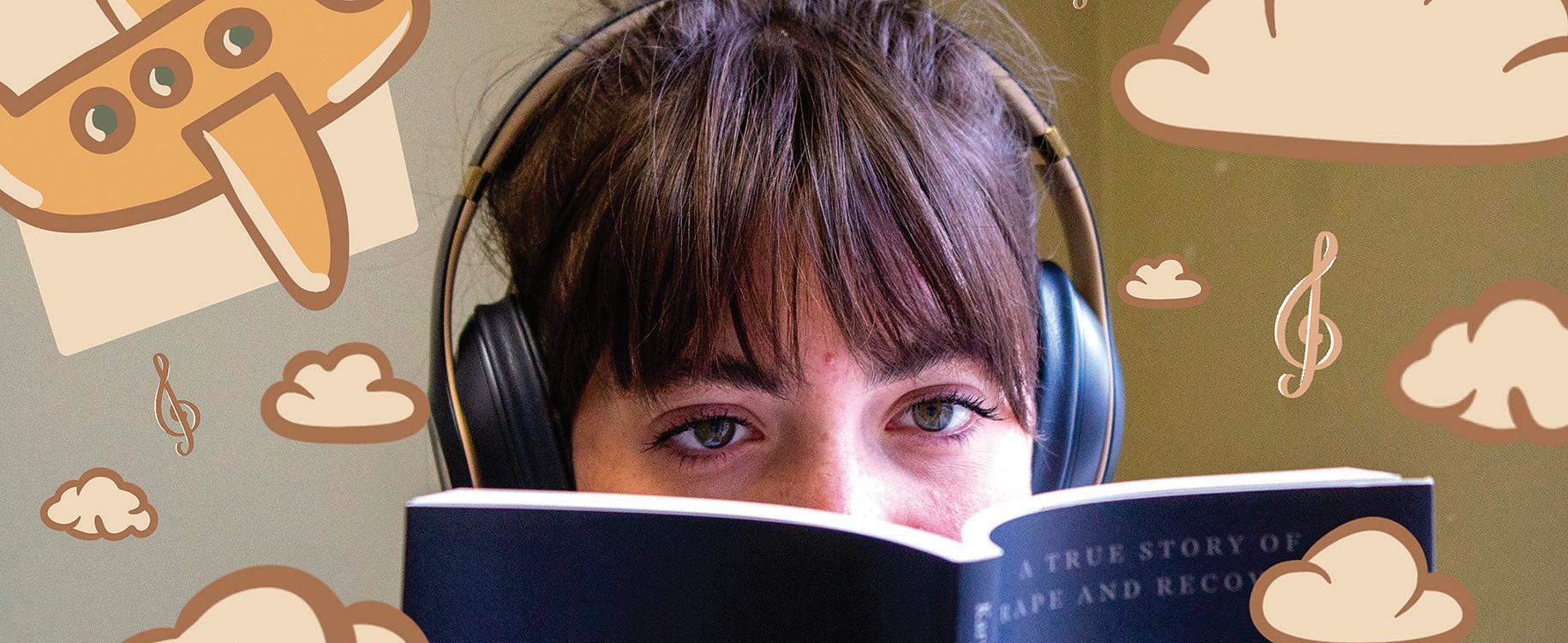
“Pingpxng” by Yin Yin OK, you’re restless as hell and mentally you’re all-out headbanging and shredding air guitar to this soulful groove. Yin Yin captured that main character feeling of being oh-so alive yet alone in your own excitement with this song’s plucky surf rock guitar rhythm.
“My Little Corner of the World” by Yo La Tengo
And at last, your arduous journey is over—the plane has made contact with the tarmac and you’ve landed in your own little corner of the world. The soft and simple guitar chords paired with mature, melancholic vocals in “My Little Corner of the World” give one the feeling of a new beginning in any place, be it foreign or familiar.
CANVAI’ll never forget the moment I stepped into the ancient Iran section at the Louvre Museum in Paris this summer. Tears glazed over my eyes as they feasted on the massive artifacts that covered every wall of the room. I was surrounded by giant panels of blue-painted bricks, pieced together like intricate puzzles. There, standing among the quiet murmur of other Iranians searching for a glimpse of their heritage in a foreign land, I, for just a moment, felt at home.
I’ve lived my whole life in Canada and have had the privilege of learning from two cultures; the one that runs in my veins—Iranian—and the one I was born into—Canadian. To me, home is not a place but the feeling I get when I tell someone my name and they pronounce it correctly. It’s the car rides with my mom where we blast songs she grew up listening to that are now banned in her home country. Or the feeling of standing in a room full of Iranians, halfway across the world from their homeland at a renowned international museum, knowing we all understand a bit of each other’s stories.
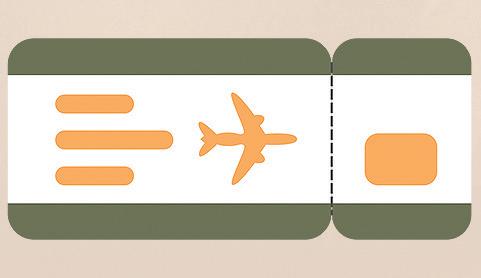
After leaving the Louvre, I found myself looking for pieces of Iran everywhere I went. The mountains in the backdrop of Barcelona and the narrow, stone streets of Athens reminded me of the little time I’ve spent visiting Tehran.
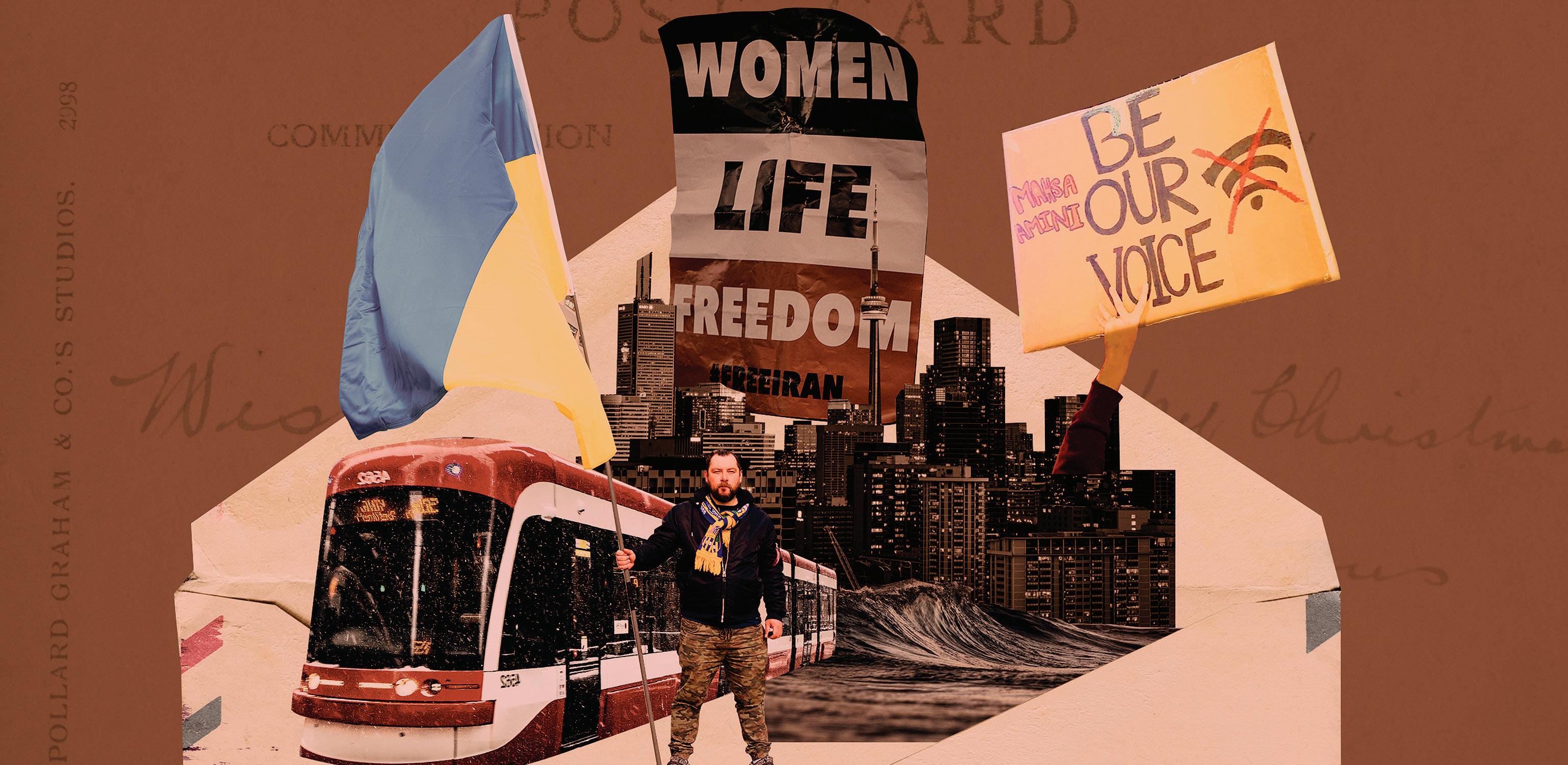




I was left longing for more, but I can’t easily travel back to my motherland. Even before the current uprising, the high cost of travel and increasing political tensions would’ve made for a challenging trip.




Now back in Canada and in school, my ears perk up every time I hear Persian chatter on campus, which is almost inevitable whenever I walk down Gould Street. In the past, hearing this chatter

used to instantly lift my mood with a sense of familiarity. These days, it breaks my heart each time, as I know we’re all grieving. I fight the urge to go up and ask how they’re dealing with it; if they too spend their days on an endless cycle of scrolling through their phones looking for updates on the Iranian revolution.

The current revolution in Iran is calling for the complete overthrow of the oppressive Regime. It was sparked after the death of 22-year-old Zhina Amini (globally recognized as Mahsa Amini), while she was detained by the Islamic Republic’s morality police, sending shockwaves through the Iranian diaspora.
Watching my motherland go up in flames from afar—though it’s not the first time—has been one of the most unsettling experiences of my life. It reminded me of the privilege I have to live in Toronto and has fueled my commitment to being the voice of Iranians who are fighting for their freedom.
For many Toronto Metropolitan University (TMU) students, including myself, the idea of home is tainted by the sadness of knowing we can’t easily travel back, for various reasons. Currently at TMU, there are 4,000 international students from 140 different countries, not including Canadian citizens or permanent residents from diverse backgrounds, according to the school’s International Student Support (ISS) website.
Among these students, many come from countries currently under severe unrest and war, including Iran and Ukraine. As they cope with unrest in their homeland, while unable to travel back, many students at TMU say their daily lives have been interrupted
by the current crises.
Their education and mental health have been negatively impacted and they wish the university offered more substantial support to their communities and helped raise crucial international awareness in times of need.
Mehrunissa Ali, a professor at the School of Early Childhood Studies at TMU, says the responsibility of providing support falls on multiple parties. For students, she says they’ve got to reach out and express the challenges they’re facing because of what’s happening back home. She also encourages students—both individually and collectively—to mobilize themselves and advocate for their needs.
Ali adds that family and community members need to be engaged in supporting young people who are impacted by conflict in their homelands.
She also encourages the university, especially their bodies facing international students, to reach out and ask students how they can be supported. “All parties need to come together to figure out what kind of support the students need and where they can get it,” she said.
Wake up, check your phone, scroll for hours looking for news, share it, try to keep up with your regular responsibilities, maybe show up to class, sleep and repeat. This is a routine Aveen Damghani, who came to Canada five years ago, knows all too well.
“My routine for the past 60 days has been this weird immersive social media experience,” they say tiredly. And they’re not alone. This has been the reality for many Iranian students abroad and at TMU, as they’ve been amplifying the situation in their homeland online to combat severe censorship and widespread internet outages in the country.

“You’re not there but you see all the news, so it’s this weird dual life I’ve noticed a lot of people having,” Damghani says.
The second-year media production student finally saved up enough money to go back home for the first time this year before the uprising changed their plans. They took a moment of silence, reflecting on the situation, before admitting that while it’s devastating, those in the diaspora need to use their position to help any way they can. “I think while every Iranian is affected during this time, people really need to consider their socioeconomic position in the midst of all this,” they say. “The diaspora, especially those who are not recent immigrants or refugees, need to be a lot more aware of their privileges.”
Usha George, professor and academic director at the Toronto Metropolitan Centre for Immigration and Settlement, explains that the majority of international students are under pressure to find part-time jobs and help support themselves or their families, making traveling back to their homeland unfeasible.
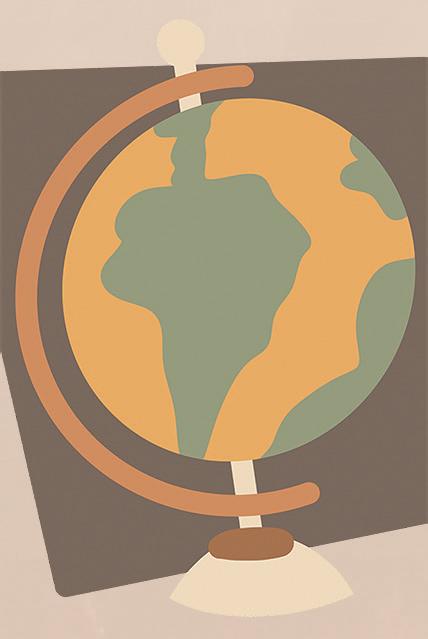
“They don’t have the kind of money to travel home and come back in two weeks. That’s a luxury.” Most students have to spend their time-off either taking extra classes or working, she explains.
During this time, visiting Iran is not a priority for Damghani. Instead, they’re doing everything in their power to be the voice of Iranians and help advance the revolution however they can.
“I’m just going to keep praying and be hopeful that this all works out. Then I will go back and see everyone…and travel,” they say, taking a deep breath before continuing. “It’s difficult knowing this time my inability to travel back is out of my control and not just for financial reasons,” their voice wavers as they let out a quiet exhale.
The Centre for Excellence in Learning and Teaching (CELT), organized a drop-in session for Iranian graduate students at TMU to discuss the uprising on Oct. 4. According to a summary of the event posted online, students expressed that the deep anxiety caused by the ongoing and increasing violence in Iran has impacted all aspects of their lives.
Damghani, who reached out to their faculty for support, was disappointed to find there were no specific resources available to them when they needed it and instead, was asked to help the department create ways to assist Iranian students. Ultimately, they wish the onus wasn’t on the students to build this support-system for themselves, by themselves.
“There has been almost no communication from the school about their resources for Iranian students right now,” Damghani says. “There was one email after a few weeks of the protests, maybe one more since then but the message is always buried and it’s nothing more than a simple hashtag of Mahsa Amini in a post about mental health.”
Various posters, some displaying a map of Iran with the call-toaction: “Be the voice of Iranian people,” while others have longer descriptions of the current crisis with the slogan: “Woman, life, freedom,” have been placed around campus. All were designed and distributed independently by Iranian students themselves.
In an email to The Eyeopener, a TMU spokesperson said the school hosts a variety of events to support the needs of international students, such as providing mindfulness and meditation sessions.
Since the start of the uprisings in Iran, president Mohamed Lachemi has yet to publicly address the situation and offer support to Iranian students at TMU. On Sept. 29, two weeks after the crisis had begun, a message from the interim vice president, equity and community inclusion was buried in a TorontoMet Today newsletter expressing that the school is “deeply saddened” by the situation in Iran and offered some resources available to students in need.
CELT, which has been offering support to Iranian teaching and graduate assistants, shared a list of students’ concerns that were expressed to them online.

“Students are concerned about not being able to access funds from Iran and worry that the current tuition extensions will not be enough, especially if the situation continues,” the list states. Among other highlighted concerns is students’ fear of asking for support, expressing that many professors, supervisors and colleagues are not aware of the situation which has led to further isolation and anxiety for students.
The document also explains that acknowledgement and supportive actions from faculty, staff and the wider university community about what is going on provides necessary validation about how students are feeling and the trauma they are living with.
As of now, the protests and violent crackdowns in Iran are in their third month, as the government increases its tactics to suppress the movement.
Feeling anxious and homesick is not uncommon during difficult times and Damghani has built habits to help overcome these emotions and remind them of their home.





“I like to listen to old revolutionary songs with my mom,” they say, with a faint smile creeping across their face. “I also really like to read and listen to [Iranian] poetry.”
Daniel Shulgatyy was three years old when his family came to Canada from Ukraine. He has continued to maintain his relationship with his culture by attending Ukrainian classes and events in Toronto. “I’ve always just been involved in the Ukrainian community in Canada,” he says. “That’s why I feel so attached to Ukraine.”
The last time Shulgatyy was able to go back home was in 2018, though he had a trip planned for 2020 which was delayed due to the pandemic and eventually cancelled altogether when Russia invaded Ukraine in February.
“When the war started, the first three days, life certainly felt surreal,” he says. “There was this kind of unity, everyone was shocked and completely dismayed by the same thing,” he says, reflecting on how the war has reinforced his connection to his culture. “It was a really strange but beautiful moment,” he says.
Shulgatyy, like many others, has been trapped in the cycle of scavenging the internet for updates on his homeland. “I did that way too much, especially at the start of the war,” he says. “Its really hard to look away when every other hour the city is being bombed where your grandma lives.” His grandmother is now a refugee because of this war and was living with Shuglatyy’s family for months, before moving to a retirement home. The best ways he’s found to cope is to communicate with other Ukrainians, talk about how everyone is doing and keep tabs on each other’s families. He says it helps to connect with others. “I feel like staying out of it would make me feel even worse and anxious about it.”
Staying in touch with his Ukrainian roots since the war has meant he’s listening to a lot more Ukrainian music, especially EDM genres which he enjoys most.
He also explains the connection he now feels to Iranians. While he admits he never connected Ukrainian and Iranian communities together before, he’s now witnessing his Ukrainian friends attend rallies along with Iranians. “These circumstances bring people together,” he says.
As a student, his struggles also seeped into his academic performance. “It was really hard to pay attention and do work when I was so worried about how my family is doing back in Ukraine.”
Shuglatyy feels the university lacks support for students like him. “I haven’t heard anything from them,” he says of the university’s approach.
The first-year student wishes the school would at least raise awareness about the war and help promote fundraisers as Ukrainians gear up for winter. “We need a lot of winter military equipment in Ukraine,” he says. “Boots, hats, socks, things to keep soldiers warm.”
In the same email statement from the school, the university stated it stands with the many voices around the world calling for peace and hopes this conflict will come to an immediate end. They also provided links to mental health and wellbeing resources on campus.
Marusya Bociurkiw, a professor in the RTA School of Media, suggests looking further than just mental health assistance for students impacted by war and conflict.
“The conversation becomes too easy for the university when we just focus on wellness,” she says. “I think their needs are less
about wellness and counseling and more about financial and moral support.” Students come here having no idea how expensive it is to live in Toronto, she explains, referring to the high cost of rent and increasing price of groceries, among other necessities.
When looking at competing universities, TMU’s approach has been different. “They have not offered any specific financial support for Ukrainian students,” Bociurkiw says, referring to scholarships and waiving tuition.
The University of Toronto, for example, quickly announced a $1 million matching fund for donations supporting displaced students from Ukraine, along with emergency aid to current students who are affected by the war, as stated on its website.
According to Bociurkiw, TMU has only funneled a small amount of provincial money to Ukrainian students through the Ministry of Colleges and Universities, which established a Ontario-Ukraine Solidarity Scholarship. The university has allocated four scholarships through this, of $10,000 each to students from Ukraine, Bociurkiw explains.
“That’s a drop in the bucket,” Bociurkiw says. “There is really a lot more that can be done financially.”

As a response to these comments, the university highlighted the Emergency Bursary for International Students, a one-timeonly, non-repayable award based on financial need due to an emergency situation.

Since then, TMU’s Support Ukraine Group, organized by faculty members, has created a donation portal to help raise funds for Ukrainian students to help meet their basic needs, provide them with the ability to continue pursuing their education and help give them stability in their lives.



Shulgatyy says he wants Canadians, especially in schools, to understand how the war has anguished the Ukrainian community. He talks about his mom, for instance, who had to organize for his grandmother to flee to Poland, then to Canada. His grandmother had to travel for two days.

“It really does affect us,” he confirms. “There has been an exorbitant amount of stress caused by this war.”
“People should realize that this war affects everyone, not just in Ukraine,” Shulgatyy says.

As an Iranian-Canadian student, I’ve witnessed how, as a student, feeling supported at the university is key in ensuring student success and wellbeing. Seeing administrators and professors take initiative to allow more conversation, in classes and on campus, surrounding current and diverse issues, gives students the space to release some of the burden they feel they’re carrying alone.
When I was still in my undergraduate program, I took an English course where my professor shared examples of literature set in Iran. Sitting in that lecture hall, discussing “Persepolis” by Marjane Satrapi and “Prisoner of Tehran” by Marina Nemat among many non-Iranian classmates was the first time I’ve had the opportunity to speak about my background in a TMU classroom. Spending multiple hours on campus and dedicating time and money to the university can make school feel like a home-away-from-home for many students, especially when their actual ‘home’ is millions of miles away. TMU has made positive strides in establishing itself as an inclusive institution, but its diverse students continue to feel stranded in their times of need.


When I’m watching videos of my people bleeding-out on the streets of Iran, as I sit comfortably in my house across the globe, the meaning of home is diluted to a mere fantasy— a hoax. I’m left to juggle my guilt and my pride, struggling to make sense of it all, so forgive me if I may not have the bandwidth to ask you to care for me.
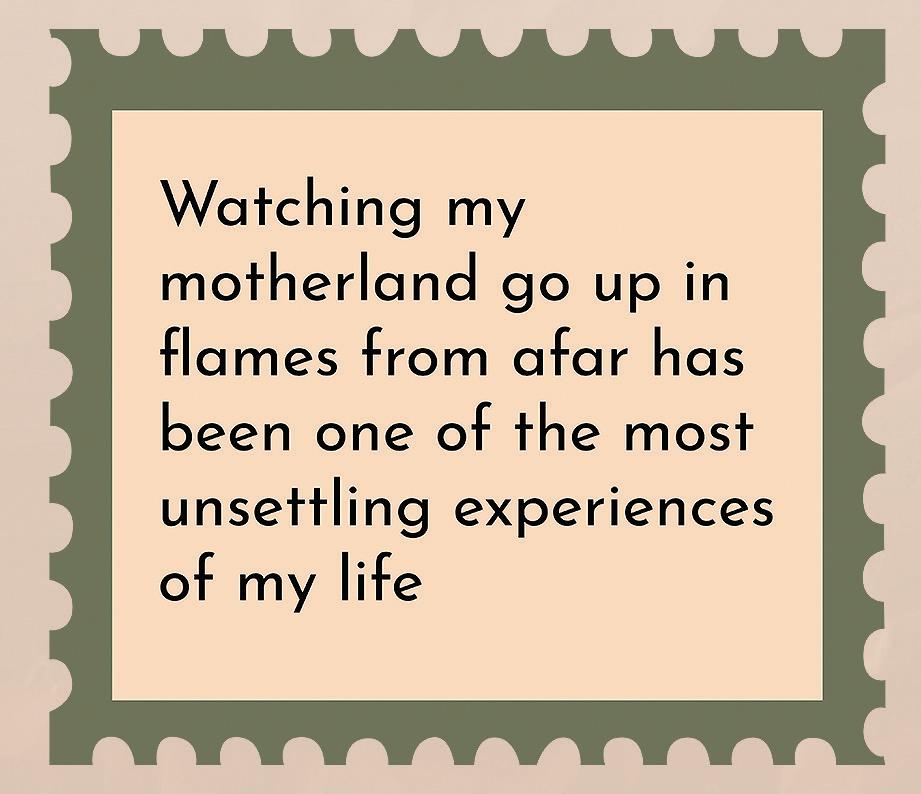
As a student from a diverse background, you aren’t always in a headspace to reach out and create pathways for the school to support you, nor do you always know how to build those connections.
Instead, I wish TMU and its faculties established a more effective and consistent way to communicate their support for students from Iran, students from Ukraine and all other countries in conflict. Especially during critical and time-sensitive cases.
As part of the next generation of knowledge keepers, I have made it my mission to learn more about the culture and history of Indigenous Peoples in Canada. Since I’ve been on this journey to reconnect with my Mohawk, Turtle Clan background and become more active in my community, I’ve realized it can sometimes be hard to find the cultural resources that are needed to accomplish this. As I have just started to formulate relationships within my community, it can be difficult to access traditional knowledge such as languages, cultural practices and history.
Through tourism, Indigenous communities have invited Canadians and other travelers to experience and engage with Indigenous environments, cultural practices, heritage and knowledge. The educational part of tourism has been able to create a better understanding between Indigenous and non-Indigenous people in Canada. For many years, Indigenous tourism did not incorporate Indigenous voices, making it difficult for Canadians to access authentic Indigenous experiences, perspectives and cultural information.
In an article for The Discourse, investigative journalist Francesca Fionda found that many Indigenous-themed items in Vancouver souvenir shops were fake. This, in turn, can contribute to a loss of wages for authentic Indigenous artists and impact their livelihood. In contrast, shops that collaborated with Indigenous Peoples gave credit and compensation to the artists, boosting their art instead of appropriating it.
industry perpetuated the idea that all Indigenous Peoples are the same. This is an example of how the tourism industry in Canada was approached through a Eurocentric perspective, similar to the history of Canada and how it became a country.
When European settlers arrived on the coasts of what’s now known as Canada, they looked upon a seemingly untouched gold mine full of resources waiting to be plucked. The Indigenous Peoples who have been on this land since time immemorial—long before the early European settlers arrived—also recognized that their land had much to offer. When the Europeans first arrived, Indigenous communities welcomed them as long as the settlers were to be respectful. Indigenous Peoples even helped their new neighbors adapt to the harsh land and climate.
thentic Indigenous perspectives, cultural practices, knowledge, heritage and history, according to Susanna Heldt Cassel and Teresa Miranda Maureira’s article “Performing identity and culture in Indigenous tourism—a study of Indigenous communities in Québec, Canada” from the Journal of Tourism and Cultural Change
As Indigenous tourism continues to grow, it is important to consider the positive and negative impacts the industry can have on communities and individuals involved.
Cassel and Maureira explored the impacts of Indigenous tourism within host communities, saying that tourism is advertised as positive for economic, social and cultural development. However, it can also be hard to navigate due to the amount of stereotypes and misconceptions directed toward Indigenous Peoples.
tourism but it was really people’s misconceptions about who Indigenous people are, being backed up by various non-Indigenous organizations,” said Johnston. “These perpetuated stereotypes and misconceptions really did a lot of harm in the relationship between Indigenous Peoples and nonIndigenous Peoples.”
Without organizations like ITAC and Indigenous-run businesses, the Indigenous tourism industry perpetuated stereotypes and misconceptions about Indigenous Peoples, which defeated the educational benefit of these tourism experiences. It also made it harder for Canadians to access authentic Indigenous tourism experiences. Johnston discussed that it was hard for people to tell if organizations were genuine, because many non-Indigenous tourism organizations would pose as authentic.
present their cultures in a way that highlights that we are all different,” said Johnston.
Unauthentic Indigenous tourism can spread misconceptions and stereotypes and has proven to damage the relationships between Indigenous and non-Indigenous people. Authentic Indigenous tourism provides Canadians with opportunities to educate themselves and learn about Indigenous cultures, languages, perspectives and history. Tourism allows for Indigenous people and communities to share their cultures, history and languages themselves, creating a deeper connection and understanding between themselves and outsiders.
If Canadians participate in Indigenous tourism experiences it can help abolish the misconceptions and stereotypes, while fostering better relationships between Indigenous and nonIndigenous people.
Authentic Indigenous experiences can also provide learning opportunities for Indigenous-identifying youth and young adults, who are on a journey to reconnect with their cultures and languages.
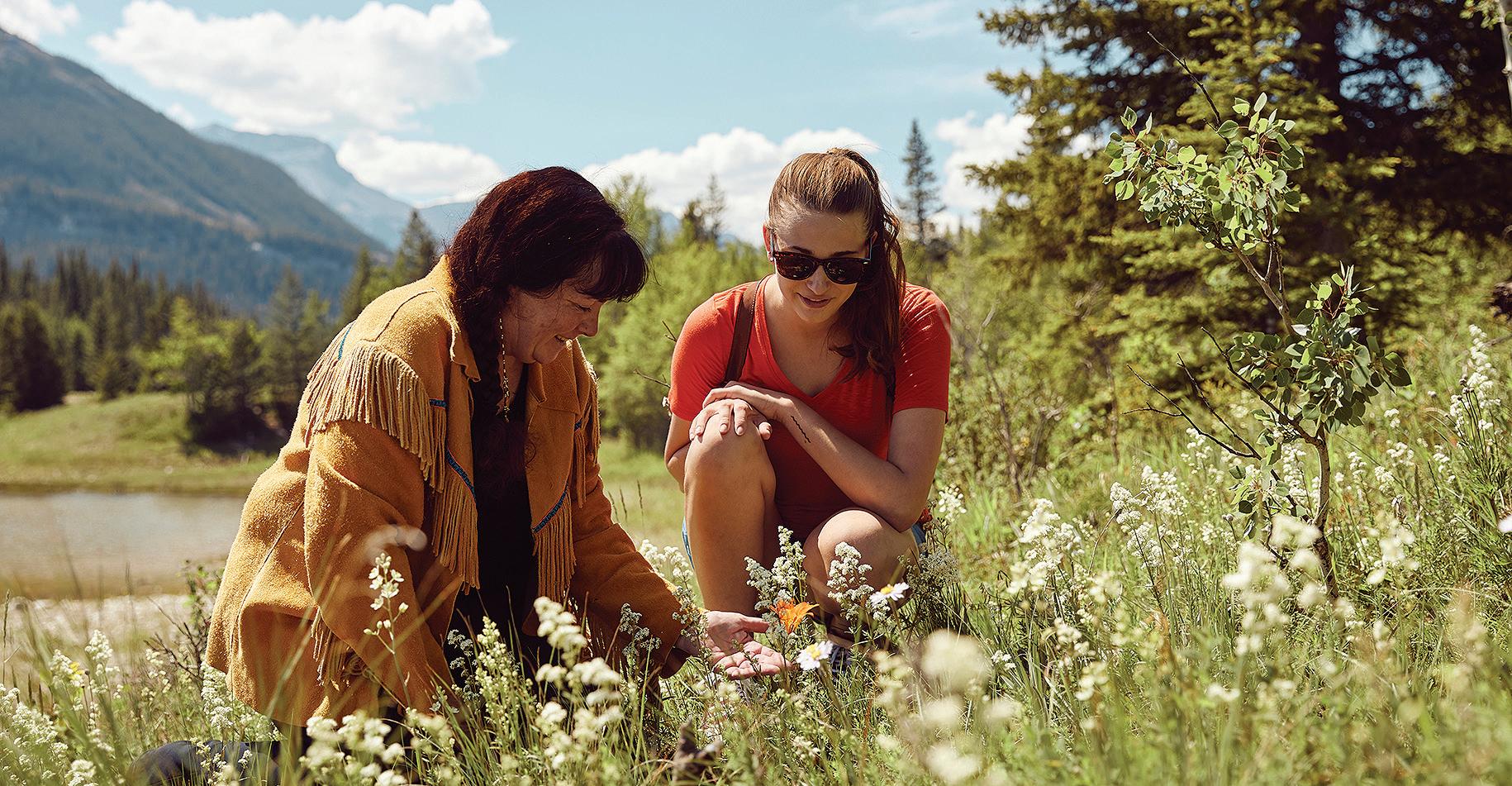
According to Cassel and Maureira, tourism can inspire people within the community to reconnect with traditional languages and cultures. They found involvement in tourism encouraged Indigenous community members to learn more about their languages and cultures.
Jason Waub-Addick Johnston, who is Anishinaubae from Chippewas of Nawash Unceded First Nation and the Ontario representative on the board of directors at the Indigenous Tourism Association of Canada (ITAC), said Indigenous perspectives have been neglected within the tourism industry in the past.
“Tourism has been around for a long time and for most of that time in Canada, the Indigenous perspective was presented in a very Eurocentric way, in that the Indigenous perspective pretty much didn’t exist,” said Johnston. “There were [European] ideas about who Indigenous people are, what they do, what they feel and what cultures and customs they have.”
Johnston also said Indigenous tourism was presented through a pan-Indigenous lens, meaning the tourism
However, as the land saw more and more European immigration from the early 1500s and on, Indigenous Peoples were forcibly removed from their traditional land and cut off from resources, according to First Nations in Canada. The relationship between Indigenous and non-Indigenous people became tarnished with greed and power.
As colonization and assimilation became a forced reality for Indigenous Peoples, Indigenous voices and perspectives were pushed aside and silenced. Johnston said the Euro-Canadian view of Indigenous Peoples and communities was based on outsider knowledge and stereotypes.
However, in recent years many Canadians have become enlightened about Indigenous Peoples’ history, which the government has historically attempted to conceal.
More Canadians are becoming interested in close contact with Indigenous cultures and are seeking out educational tourism experiences that provide access to traditional and au-
“The interaction between hosts and guests in tourism then not only becomes a transaction of money but also involves the exchange of expectations, stereotypes and expressions of identity and culture,” the article noted. “And both groups are affected by each other.”

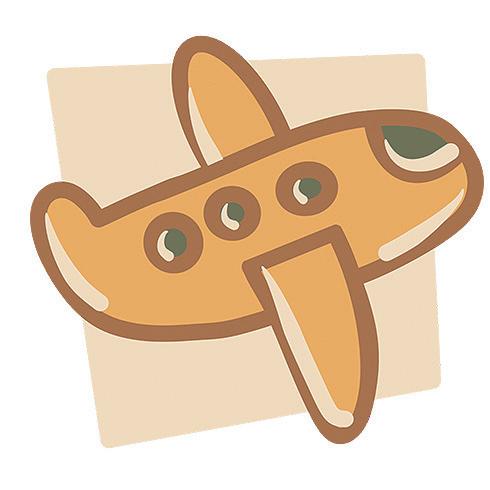
Organizations like the Indigenous Tourism Association of Canada (ITAC) are making it easier to find educational resources and access tourism experiences. The ITAC launched a new website called Destination Indigenous in 2020, a Canadawide vacation planner for anyone who’s interested in Indigenous tourism experiences.
Johnston discussed a wellknown saying in Indigenous tourism: “Nothing about us, without us.” This touches on the idea that Indigenous tourism can not exist without Indigenous voices and perspectives, he said.
“There was a very big demand for what would be considered Indigenous
As more Indigenous-run tourism organizations like ITAC join the industry, the Indigenous tourism sector is evolving and becoming more authentic, as Indigenous cultures are now being presented from an Indigenous perspective. Johnston said authentic Indigenous tourism can provide economic and cultural
“There are clear economic benefits from tourism bringing money into the communities, supporting businesses and artists,” said Johnston. Authentic Indigenous tourism has also provided Indigenous communities with control over how their cultures are presented, which is helping to diminish the pan-Indigenous lens.
“Indigenous people need to be in control of Indigenous tourism, to
Johnston talked about how valuable it was for Indigenous communities, specifically youth, to have the opportunity to represent themselves and their cultures as they reflect on their identities.
“Being able to promote and represent ourselves, from our own culture, our own perspectives and our own people, without having to fight back against stereotypes, is beneficial to the community and to the youth, because it helps us see ourselves for who we are,” said Johnston. “We are strong, resilient people with amazing cultures, languages and histories we are proud to share.”
I believe that Indigenous tourism is a powerful tool because it encourages more people to connect with the cultures, languages and histories that the Canadian government tried to destroy. Indigenous youth like myself can find resources through organizations like ITAC to reconnect with our heritage and participate in the resurgence of Indigenous cultures.
As citizens of a multicultural nation, it is important to understand and celebrate the diversity of our people. Indigenous tourism is a way for Canadians to learn about Indigenous cultures, from Indigenous voices and perspectives. To understand our history is to forge a pathway that will lead us to a better future for Indigenous and nonIndigenous people.
First, we must listen to each other in hopes of understanding one another.
Indigenous communities are representing their own cultures, languages and history through tourismCOURTESY: INDIGENOUS TOURISM CANADA
“Being able to promote and represent ourselves... helps us see ourselves for who we are”
“We are strong, resilient people with amazing cultures, languages and histories”
When I first landed safely in Toronto and stepped off the plane from Regina in January 2022, I played into the cliché movie trope of glancing around wistfully and taking in my surroundings to calm my anxiety. I breathed in the new—albeit funky-smelling—city air and metaphorically turned the page to begin a new chapter in my life. One that was taking place away from my home, family, friends and beloved cat, Muggles.
As I trudged through the airport, I became uncomfortably aware that the people who raised me were now more than 2,500 kilometres west of me. “I’m only a phone call away,” my mother’s words looped in my head. I couldn’t help but wonder what would happen if and when I ever needed more than that.
“They have to make new friends, they have to learn new ways of doing things,” she says. “It’s a totally different world for them.”
the moment she was left on her own.
dent Support (ISS) organize bonding events. Through social gatherings like game nights and karaoke, these services attempt to “build community amongst international students and enhance social connections,” said the university in an email to The Eyeopener.
George suggests, in addition to taking advantage of the university’s services, students should reach out to new friends on their own. “You have to be resourceful in locating services and ideas and people that you want to connect to,” she says. By taking that initiative, students can build a strong foundation in their new environment, George adds.
I quickly learned to turn to my classmates to relieve the feeling of homesickness. Though the friendships were new, small inside jokes, frequent coffee dates and shared stress over piles of assignments were more than enough to create strong bonds.
While the persistent loneliness I felt as I learned to thrive independently was a daunting, all-encompassing feeling, it was not a unique one. Many Toronto Metropolitan University (TMU) international, out-ofprovince and exchange students say they have felt—and still feel—this sense of isolation as they live apart from the people and cultures they’re most familiar with.
Stepping into an entirely new environment requires a big adjustment on the student’s part, says Usha George, a professor and academic director at the Toronto Metropolitan Centre for Immigration and Settlement.
Alyssa Tan, a second-year business technology management student, recalls feeling lonely in her first year. As an international student from Malaysia, she says she was thrown into a completely new cultural environment with little support when she moved to Toronto in her first year, which was an isolating experience. Tan missed her family dearly, especially her mom’s cooking. Despite this, she tried to keep herself busy to avoid feeling homesick.
“It also is good in a way because keeping myself busy, as in joining a bunch of student groups and things like that, helped me to make friends,” Tan explains.
She says she initially struggled with selfdoubt, wondering if she would be able to cope without her family back home. But as Tan strengthened the relationships she had made on campus and lived independently, she says she learned a lot about herself. “I’m much more capable than I thought I was,” Tan says.
Hannah Vlam, a third-year arts and contemporary studies exchange student from the Netherlands, says she has also struggled with living away from her family. Though Vlam’s mom accompanied her to Canada in August, which kept her company for a couple of weeks, Vlam immediately felt overwhelmed
However, Vlam says she is trying to be present while she is here. “I think back to the Netherlands and when I was there, I was just looking forward to Toronto the whole time,” she expressed. Vlam is only here for four months. She says she is making the most of it by spending a lot of time with the friends she has made on campus.
Vlam says it’s important for other students living away from home to step out of their comfort zones and make friends in similar situations. “They all have the same experience, so you’re all supporting each other,” she says.
Although Tan has been involved in school activities since her first year, she notes that the pandemic made it a bit more difficult to do so. This isn’t unique to Tan. As the pandemic restricted students from forming roots in their community—not only in a geographical sense but also in developing relationships with classmates—it caused widespread loneliness among them, according to a study by The Geographical Journal.
The need for that sense of community among students is growing, according to the study. It noted that the decision to study abroad is not only motivated by the chosen school’s academic reputation but also its community engagement.
On the other hand, Tan says not to worry if a solid friend group doesn’t form right away. “There are things that are not going to go right and that’s okay, that’s where you learn,” Tan reassures.
George says engaging with other students who have shared interests is integral to forming relationships throughout university—but it takes time and dedication.
But stepping out of your comfort zone can be easier said than done, which is why university departments like the International Stu-

 By Zarmminaa Rehman
By Zarmminaa Rehman
For many international students at Toronto Metropolitan University (TMU), they feel overwhelmed in their new environment while trying to adjust. According to a 2019 HSBC survey, 43 per cent of international students reported that they feel homesick at least once a week even once they’re settled in. Sometimes the only saving grace for TMU’s international students is a hearty meal or familiar snack that reprises dear memories of home. The Eyeopener asked international students on campus what their comfort meal is when they’re missing home. Here is what they had to say:
Vada pav and Dosa: India
Third-year professional communications student Rajalaxmi Nayak has not been able to find her hometown’s famous vada pav since arriving in Canada in January 2022.
Vada pav is a classic street food from Mumbai (formerly known as Bombay) consisting of fried potato mixed with spices, between a bread bun, layered with sweet, sour and savoury chutneys. Vada pav’s roots can
be traced back to 1966, when Ashok Vadiya opened the first vada pav stall outside the Dadar train station in Mumbai, India. The snack offered people who were en route to work something to eat that was both effortless, delicious and inexpensive.
“It’s a street food, so it’s not a traditional dish but it is something that if you’re in Bombay, you’re gonna have a lot of,” she said. “You have it with friends, after school [or] after college.”
Amala, Ewedu and Jollof rice: Nigeria
Second-year medical physics student Victor Ola-Matthew arrived in Toronto from Nigeria this January. Back home, he was able to enjoy his favourite dishes like Ewedu soup and Amala, both originating from his father’s tribe of Yoruba in Southwestern Nigeria.
Amala is a thick dough-like dish, usually made from yam, and is served as a side dish to the ewedu soup, which is made from green jute leaves from the Malvaceae plant family.
Each time he thinks of meals from home, Ola-Matthew says he’s reminded that it will be a while until he can taste those flavours again.
“There’s this longing for what you know you will not be having anytime soon and you have
to endure and not think about it,” he said.
Chicken:
As time continues to pass, the loneliness I once felt has transformed into nostalgia—into a love for my past and an appreciation for the places I’ve left my mark in.
Like Tan, my experience away from home has made me realize I am much more capable than I thought. While there were many failed attempts in the forms of burnt grilled cheeses, forgotten keys and missed buses, I quickly learned that independence is both a gift I should not take for granted and a responsibility that requires consistent practice.
Read the full story at thetravelissue.theeyeopener.com
Apurba Roy, a third-year professional communications student, moved from New Delhi, India to Toronto in April 2022.
“Steamed rice and butter chicken, boneless of course, [I] love it so much,” she answered when asked what her favourite and most missed hometown meal is. Roy describes the dish as both savoury and sweet with notes of spiciness. The dish consists of boneless chicken chunks cooked in a thick, buttery and creamy gravy and best paired with rice or naan.
Roy will be heading back to India in December for a visit and can already imagine the mouthwatering taste of butter chicken and rice.
“It’s just about having something home cooked more than [having] traditional [food],” she said.
Jone Aboitiz, a third-year creative industries student, hasn’t been in Canada for very long, considering she just arrived this September from the Philippines. Her favourite dishes are Adobo and Paella.
Read the full story at thetravelissue.theeyeopener.com
International students at TMU reminisce about their favourite hometown dishes“They have to make new friends, they have to learn new ways of doing things”
“There are things that are not going to go right and that’s okay, that’s where you learn”PEYTON KEELER-COX/THE EYEOPENER COURTESY OF CANVA
When Aziza Agasee visited California in 2016, her trip quickly turned sour. On her flight, her wheelchair’s power assist—which is a motor attached to a manual wheelchair—was damaged during the flight. This equipment costs thousands of dollars and luckily Agasee was able to successfully file for reimbursement. Still, this process created unnecessary stress and made the trip more difficult for the third-year politics and governance and sociology student as she could no longer rely on the feature when she was fatigued.
“It is very difficult to fly with a disability,” she says. Customer service is one of the biggest issues when travelling by air, Agasee explains. “It’s not even just all the pre-planning and kind of calls you have to make in advance, but it’s the plane staff. They’re not very understanding or accommodating to people, especially when it comes to your own equipment.”
Heather Willis, the accessibility coordinator at Toronto Metropolitan University (TMU), says airplanes are inaccessible and not designed to accommodate disabled passengers. Disabled people are unable to use their own mobility aids on board, forcing them to rely on others and removing their sense of independence.
“It’s all this extra planning that other people take for granted,” says Willis. She explains that the amount of time and energy it takes to plan simple day-to-day events while away from home can be the most discouraging part of travelling. Considerations must be made surrounding every destination on the journey, she says.
For Agasee, travelling is already a stressful experience due to the amount of consideration she needs to take and the variables which can go wrong. “You don’t look forward to wanting to go anywhere, knowing you have to go through that,” she says.
While an able-bodied traveller may only have to worry about finding the best rates on flights and hotels, disabled students at TMU might also have to consider the accessibility of those services.
Travel can mean more than just going on vacation. Many TMU students commute from outside of the downtown core to get to school every day and for some, this can be more challenging than others. The Toronto Transit Commission (TTC) is yet to become a fully accessible service, with multiple subway stations lacking elevators and bus stops having little to no indicators for the blind. College station, for example, is only accessible by stairs. While the city’s Wheel-Trans service—a sharedride public transport system that utilizes accessible vans, buses and taxis—is available, it is not necessarily timely nor comprehensive, says Willis.
As a wheelchair user, Agasee also takes an accessible taxi from Thornhill, Ont. when commuting to TMU. She says her previous experiences with public transportation have discouraged her from taking the subway. “I do know that not every subway station is accessible, so that’s one of the main reasons why I haven’t
tried it yet,” she says.
ByOnly 54 of the 75 TTC subway stations have elevators, making up about three-quarters of the stations, according to the TTC website. The lack of accessible transportation has a major impact on many lives, says Willis. A 2021 Statistics Canada report found that 17.8 per cent of Canadians with disabilities, who consider themselves housebound, attributed that to the unavailability of specialized public transportation.
As the accessibility coordinator at TMU, Willis works to create an accessible and inclusive university for all students. Willis, who is a wheelchair user, has used the Wheel-Trans service and the GO train to commute to TMU from Scarborough.
She notes what would typically be an hourlong commute takes her twice the time. She applauded the GO train for its accessibility and is glad the TTC’s Wheel-Trans service is offered but wishes it was more comprehensive so passengers didn’t have to book days in advance or experience long rides and wait times.
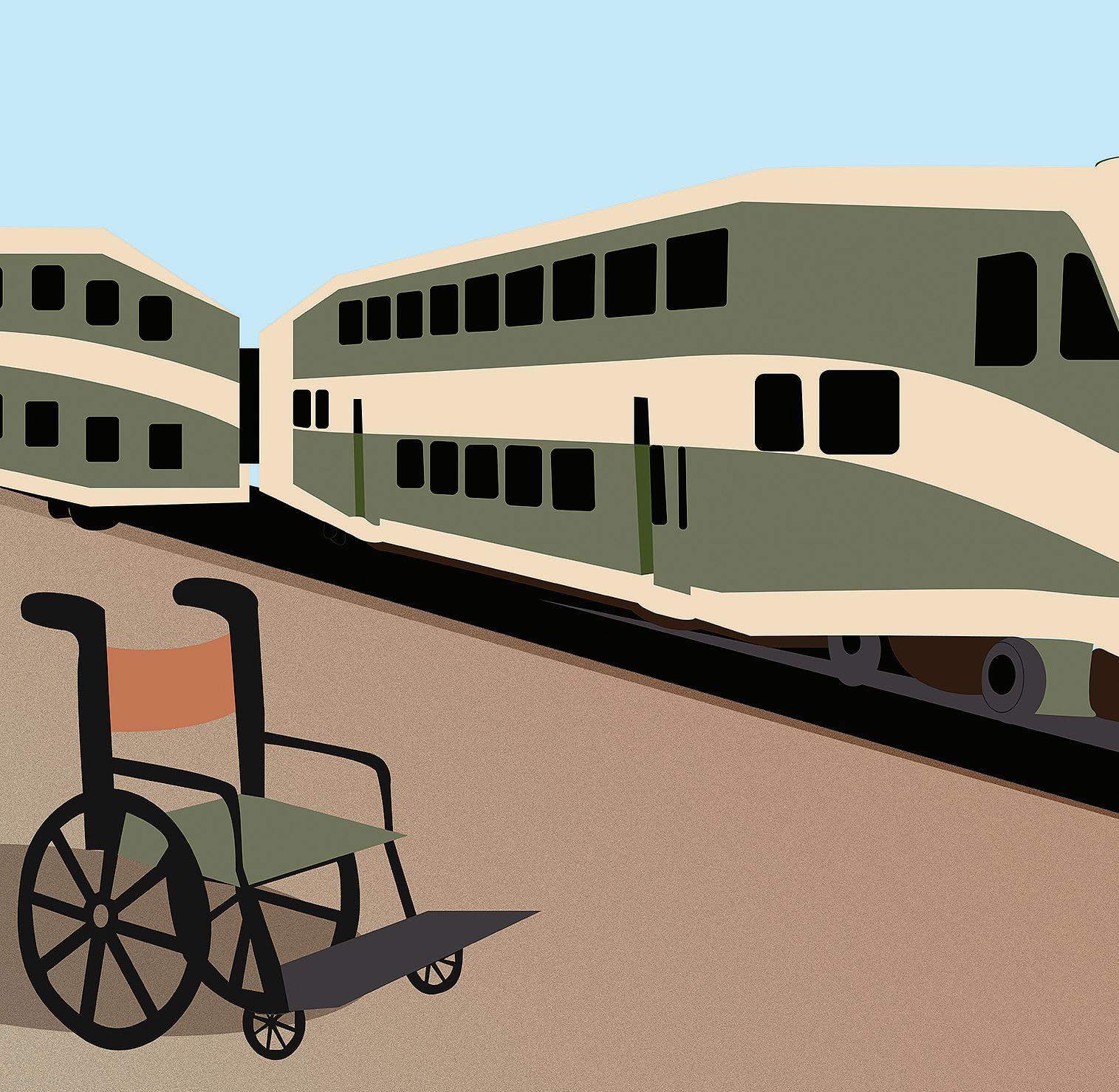
The TTC said in an emailed statement to The Eyeopener, “The TTC is fully committed to giving our customers transit options through system accessibility programs, through Wheel-Trans and by creating a seamless integration of the two systems through Family of Services.”
Macenzie Rebelo, a first-year master of journalism student at TMU, has lupus. She says travelling often doesn’t feel like a realistic op-
tion to her due to the amount of unknown factors and activities she can’t participate in due to her illness. Lupus is a chronic autoimmune disorder, Rebelo says, that can affect her lungs, mobility and causes fatigue and chronic pain among other effects. “It’s just not enjoyable, you kinda just stick out like a sore thumb and you just have to really plan out everything,” Rebelo says.
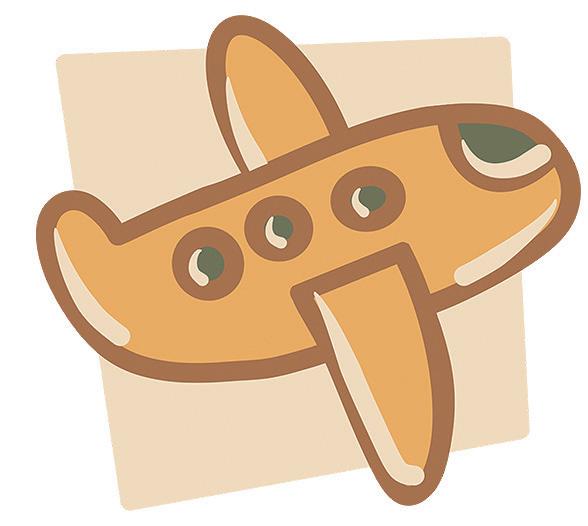
Agasee says she is often hesitant to go on trips or visit new places, worrying that her travel companions might not be understanding of the accommodations and the amount of preparation she needs. “I kind of get insecure… that person may not be understanding or may not understand what it’s like.”
“The more accessibility you have, the less individual accommodation you’re going to need,” says Yin Brown, the director of inclusion, diversity, equity & accessibility at Abilities Centre. She mentions that her needs as a blind person vary drastically from those of a wheelchair user. Because of this, the aids she utilizes are different from those with other disabilities, but this is often misunderstood.
“If you go to the desk and ask for assistance as a person with a disability, right away they make certain assumptions,” says Brown. She says often when requesting a guide, she is given a wheelchair despite being able to walk.
Accessibility may not look the same for everyone—both the definition and needs vary from person to person, says Willis. “Understanding accessibility and accommodation as different approaches is something that’s been really key,” she says. She explains that accommodation is needed when a space is not accessible, yet the two often rely on each other.
Brown spoke about the issues with the current “Accessibility for Ontarians with Disabilities Act” standards, which “mandates how organizations must remove and prevent barriers for people with disabilities,” according to their website. These standards apply to all organizations, public, private and non-for-profit, in Ontario. Brown says while the standards could be stronger, the biggest issue is enforcement.
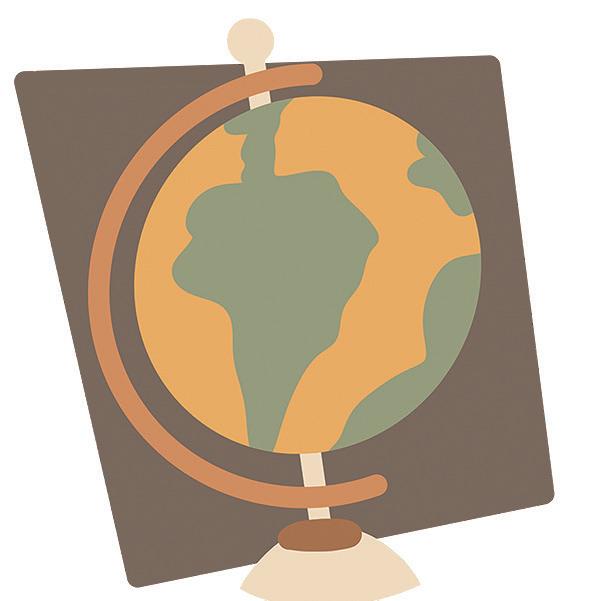
The lack of enforcement and weak penalties allow for non-compliance, she says. “Many organizations, big and small, have no idea that they should comply and they get away with it.”
Agasee expresses frustration with the broad nature of the term ‘accessibility’ as well. When staying at hotels in the past and booking rooms advertised as accessible, she has been placed in rooms which were not barrier-free. This caused her to ask, what does accessible truly mean? “I guess their version of accessible and my version of accessible is very different,” says Agasee.
Willis shares a similar experience with staying at hotels, mentioning it especially when booking an accessible room. For example, while the bathroom may be accessible, there are often other barriers such as high beds. “The bed was about a foot higher than my chair. So it was very unsafe for me to be transferring,” says Willis.
Robelo says she’s often unable to get the support she needs due to a lack of awareness or understanding of those who are not visibly disabled. She says she has a lot of anxiety about utilizing spaces and services accommodated for disabled people. In the past, she’s been harassed out of handicapped parking spaces or unable to use designated seats on public transit. “It can just feel like there’s more cons than pros when travelling sometimes and it’s not worth it,” says Robelo.
Brown’s main recommendation on how to make travel accessible is to increase training. Regardless of the profession, employees should be trained in how to help disabled people and make their services accessible, she says. Whether it be bus drivers, flight attendants or restaurant owners, changes need to be made at a human level, not only an industry level, Brown says. This sentiment was echoed by everyone interviewed.
Brown emphasizes the importance of working with communities to create an accessible society rather than guessing what disabled people need.
solution is to really work with the population group that
feel
want to travel more,” said Brown.
For many disabled TMU students, travelling brings more hassle than enjoyment
“The
you
you
“It can just feel like there’s more cons than pros when travelling sometimes”
“It’s just not enjoyable, you kinda just stick out like a sore thumb”
“It’s all this extra planning that other people take for granted”
Accessibility barriers in transportation and beyond cause recurring challenges
Nalyn TindallABEER KHAN/THE EYEOPENER
On Tuesday, first-year computer science student Patricia Bombay was discovered by roommate Petra Bald, in her dorm room at Toronto Metropolitan University (TMU) after getting lost in a virtual reality (VR) world for seven days.
Bombay purchased a VR headset from Facebook Marketplace for only $100, determined to get a break from her current draining reality. Unfortunately in this economy, $100 doesn’t even get you some good headphones, much less a reliable VR headset.
“I was really excited. $100 and I get to experience a vacation that would cost me thousands in the real world?
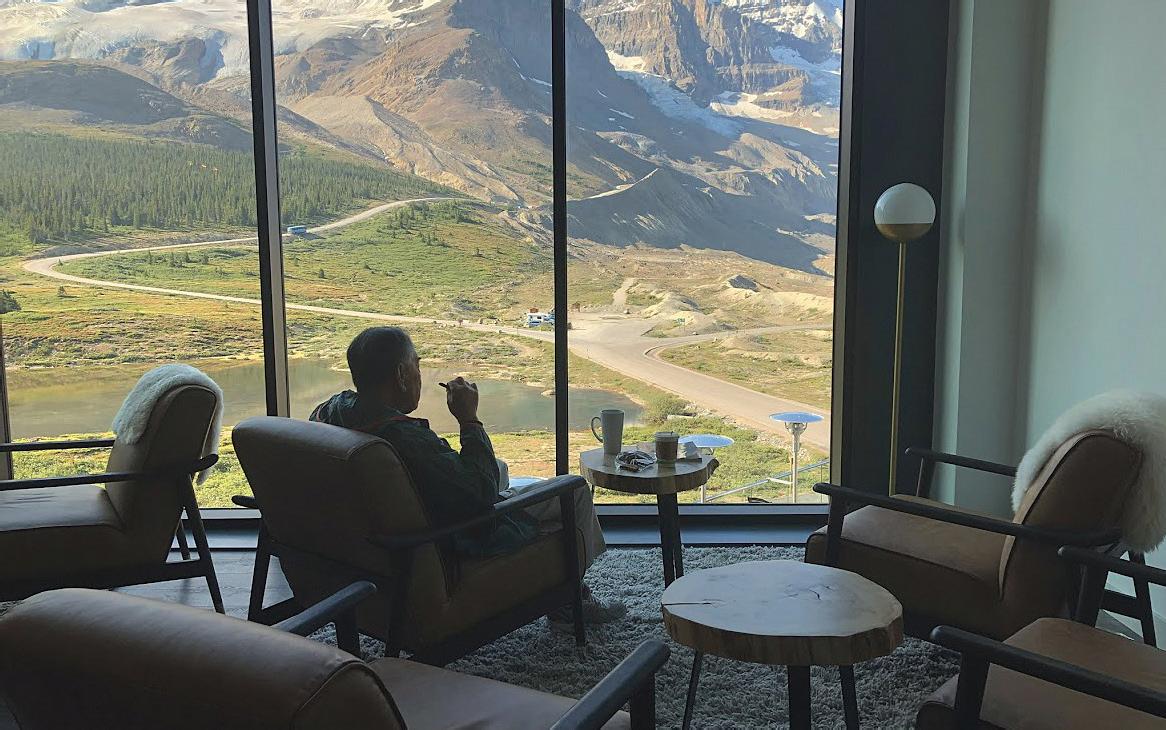
Before I knew it though, I was stuck!
It was giving…Jumanji,” said Bombay. She had been trying to go to Mexico but ended up in the Amazon Rainforest in Brazil.
As found on the website for Canada Air—a totally reliable airline—just the round-trip flight to Mexico costs between $1,000 and $2,000. For a TMU student, that’s
the equivalent of about half a semester’s tuition.
Students nowadays are drowning in financial pressure—needing to afford ever-increasing tuition, rent, textbooks and the millions of restaurants surrounding TMU.
Devon Rex, a second-year nursing student and Bombay’s best friend, said he would’ve used the headset if Bombay didn’t.
“Who wouldn’t want a low-effort vacation?” he said with a heavy sigh. “Especially with exams coming up.”
Rex had been under the impression that Bombay was just doing another social media cleanse when she was unresponsive for the seven days.
According to the social media awareness organization Media Psychology, three in four young adults will deactivate their social media accounts and put their phones on silent in an attempt to refocus on their lives. Half of those “cleanses” last less than three hours, studies show.

The actions of the desperate firstyear student didn’t rattle many due to desensitisation—but it did shock residence advisor Norman Wegian.
“We never thought our jobs would end up including finding students lost in virtual worlds,” said Wegian, who was the one to find Bombay in her room with Bald.
According to Wegian, Bombay was lying on her bed unbothered, with her face to the ceiling and a huge headset on, weighing her down.
Bombay’s disappearance also caught a lot of attention this week from the media thanks to the ever-nosy journalism students of TMU. Bombay’s response to the media coverage and attention was whether this would get her free plane tickets for a welldeserved non-VR vacation.
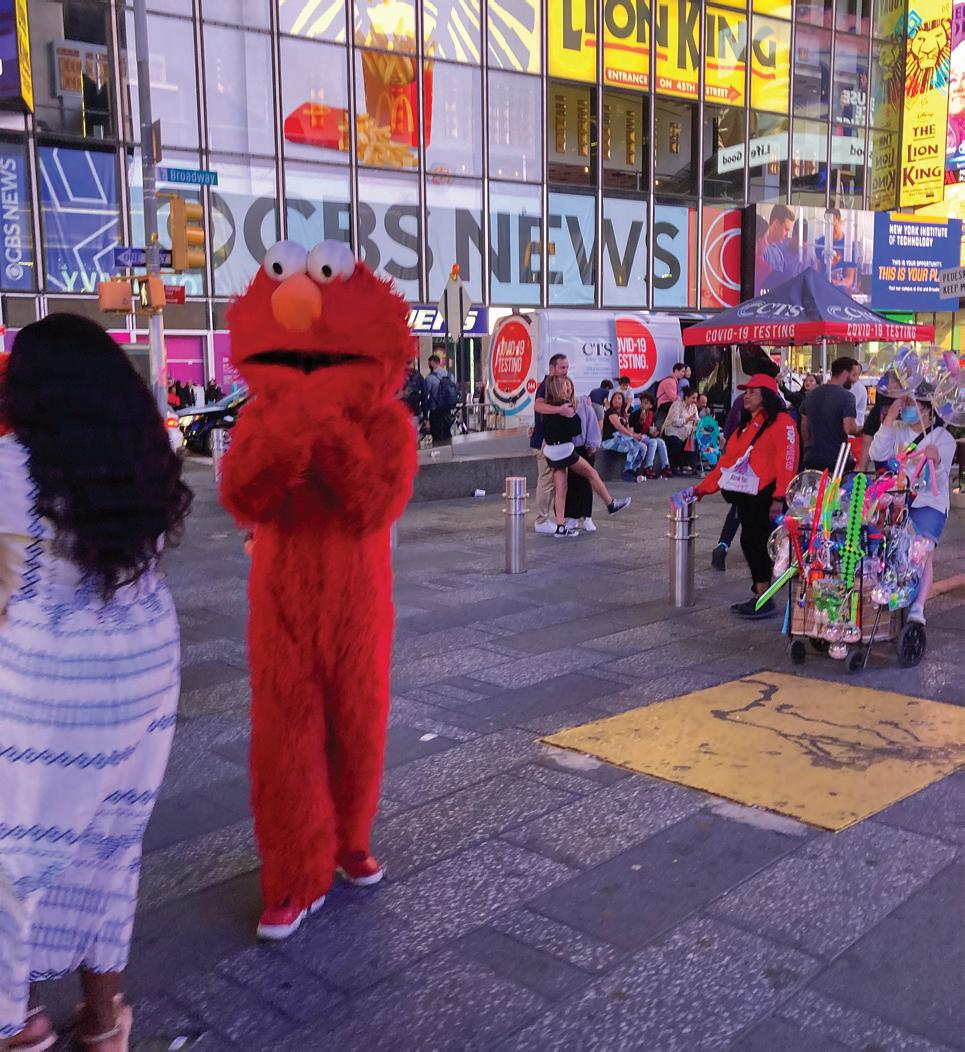




Clinical psychologist Sia Meese said the need for escapism, as displayed by Bombay, is not something new. In fact, the desire to travel and alleviate the emotional distress of school has risen by 64 per cent in just the last month. So has the need for some good therapy, which has increased by 98 per cent.

“One thing that has actually been heavily discussed in classes recently is this dawn of reliance on VR technology in society,” said Bob Tailor,
According to Real VR Stats, a website dedicated to statistics on virtual reality usage, the purchase of VR headsets has risen by 15 per cent in the last two years and Bombay’s experience is more common than you may think. In the last two months, the internet search for VR programs that give the experience
of a vacation has doubled.

In the days she was gone, Bombay missed two midterms, her anniversary with her partner and—most devastatingly—a week’s worth of class gossip on Twitter.
“Honestly, I didn’t really want to leave,” said Bombay.
“It wasn’t so bad, being lost and unable to log out, except for when I really started craving some fries and a milkshake.”

